Climate Disasters on the Planet from April 17 to April 23, 2024: Summary
Asia
China
On April 17, thunderstorms with heavy rains and a huge number of lightning strikes swept across the entire Guangxi province. The stormy weather was preceded by abnormal heat with temperatures reaching up to +39°C.

Stormy weather in Guangxi province, China
Within one day, in total, the region has seen
over 126,000 lightning flashes.
In the vicinity of Nanning city alone, over 20,000 lightning strikes were recorded during the strongest convective storm. At the Shanlin National Meteorological Station, a wind gust of 30.3 m/s was recorded, surpassing the historical wind speed record at this station.
On April 18, large hail fell in Guizhou Province, some the size of chicken eggs, which pierced car roofs and damaged crops.

Giant hail in Guizhou province, China
The city of Qianxi was hit by hurricane-force winds at 32.5 m/s.
The convective storm brought abnormal downpours. In the Pingba district of Anshun city, 125.3 mm of rain fell, exceeding the monthly precipitation norm for April – 109.64 mm.
In the area of Qingyuan city (Guangdong Province) on Friday, April 19, a rare and alarming phenomenon occurred – a “green sky,” which then turned black, making the day appear like night. Since April 19, residents of this province have been suffering from abnormal rains and storms, resulting in landslides in mountainous areas and river levels exceeding critical levels.

Massive flooding in Guangdong province, China
The storms marked an earlier start to the annual flood season in Guangdong Province, which typically occurs from May to June.
The Department of Emergency Management of Guangdong Province reported that as of April 22, dozens of houses had collapsed or were seriously damaged by torrential rains in the counties of Qingyuan, Shaoguan, Zhaoqing, Guangzhou, Heyuan, Meizhou, and Huizhou.
In the vicinity of Shaoguan city from April 19 to 21, an astonishing amount of rainfall — 584.4 mm — fell, which was 2.5 times the average monthly norm (230.3 mm). The rains caused severe flooding and numerous landslides. The overflowing Beijiang River flooded coastal towns and villages. People had to be urgently evacuated by helicopters and rubber boats.
On April 20, more than 300 emergency service personnel were deployed to rescue residents trapped by landslides in six villages of Jiangwan township.
In the area of Qingyuan, floodwaters on the morning of April 21 submerged residential and commercial buildings.

Houses submerged up to the rooftops in Guangdong province, China
Due to the flooding, there were disruptions in railway services, affecting over 300 train routes. School classes were suspended. The water level in the Feilaixia reservoir approached 100-year records.
According to the state news agency Xinhua, 4 people died as a result of the disaster, and 10 are missing. More than 110,000 residents were evacuated from flooded areas. The rains continue, exacerbating the already extremely dire situation in this region.
The severe flooding threatens China's economic stability, as Guangdong Province is a dynamically developing economic and manufacturing center of the country and one of the most densely populated and affluent provinces in China, with a population of over 127 million people.
India
Waves of extreme heat have spread across Asian countries.
In India, the ongoing heatwave has engulfed some regions of the states of Odisha, Jharkhand, and West Bengal. The maximum temperature here ranged from +40°C to +46°C, which is 4–6.5 degrees above the norm.
In the state of West Bengal, due to record temperatures, a red alert was issued. The Odisha government has declared summer vacations in all schools in the state due to the unbearable heat.

Extreme Heat in India
People cannot withstand such heat stress. A Doordarshan anchor, Lopamudra Sinha, fainted while delivering heatwave updates live on air in Kolkata.
“The teleprompter faded away and I blacked out... I collapsed on my chair” described the TV anchor. Colleagues rushed to her aid, but upon regaining consciousness, Mrs. Sinha was unable to continue the broadcast.

Heat fainting of an anchor during live broadcast, India
After that, as police officers began fainting while working outdoors, their equipment was upgraded to include helmets with air conditioning.
Unfortunately, there were human casualties. India's largest news agency (PTI) reported that 62-year-old Lakshmikanta Sahu from Maheshpur in the Balasore district died of heatstroke on April 15.
“This was the first sunstroke death this summer,” an official at the Special Relief Commissioner's office said.
Bangladesh
Bangladesh also experienced deadly heat. On Saturday, April 20, the city of Jessore recorded the highest temperature in the country — 42.6°C.
Akkas Ali, a 70-year-old worker at Mongla port, said, “I have never seen the heat that has been falling recently in my life. People cannot walk on the streets. Children can't even stay at home. God knows why it is so hot.”

Deadly heat, Bangladesh
Climatologists note that the sudden heat wave disrupts the natural balance, affecting food production, endangering marine life and livestock, but most importantly — it has a detrimental effect on human life.
The increasing heat exacerbates various diseases, with skin diseases alone rising by 20–30%. In just two days, at least three people in the country have died from heatstroke.
On April 20, due to the strong heat wave, the Bangladesh government ordered all schools, madrasas, and colleges to close for at least 7 days.
Kyrgyzstan
An emergency situation has been declared in three regions of Kyrgyzstan due to mudflows.
According to the Ministry of Emergency Situations, over three days, the country has seen
more than 40 mudflows.
Since April 20, amid continuous rains, mudflows have covered dozens of populated areas in the Talas, Jalal-Abad, and Osh regions.
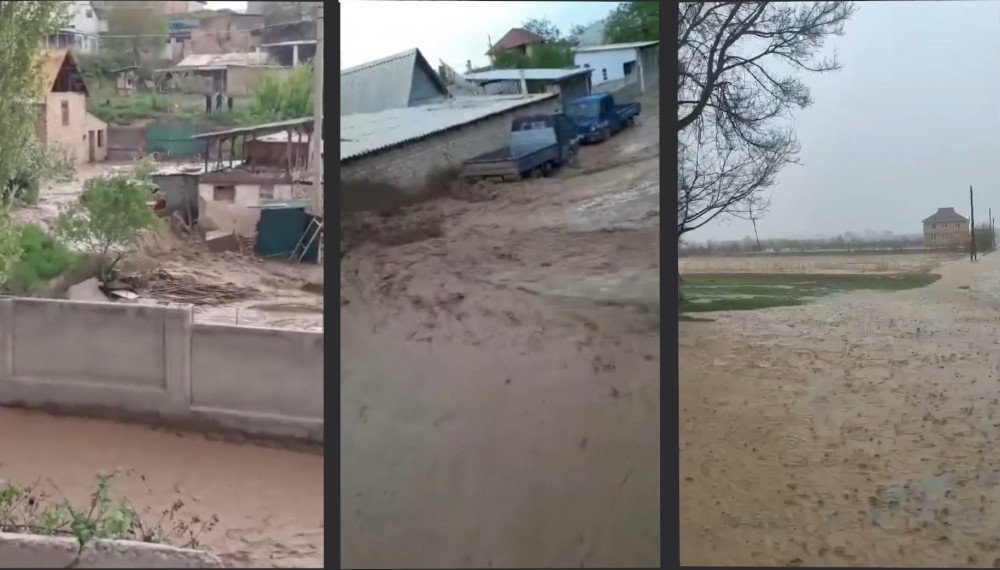
Mudflows in Kyrgyzstan
In the village of Toguz-Bulak, Osh region, a mudflow swept away a car containing a man, two women, and a child. The women and the child were rescued by locals, while the car's driver was carried away by the mudflow.
On April 22, in the village of Eski Kochkor-Ata, Nooken district of Jalal-Abad region, water broke through an anti-mudflow dam. Residents of three hundred homes were evacuated.
Iran
In Iran's Sistan and Baluchestan Province, almost four annual norms of precipitation fell in 3 days, setting a record for the region.
According to the ISNA Agency, the city of Zarabad recorded
an unprecedented amount of precipitation from April 16 to 18 — 270 mm,
with an annual average of 70 mm.

Aftermath of unprecedented precipitation in Sistan and Baluchestan Province, Iran
Another wave of anomalous rains intensified the floods that the country's residents have been suffering from for months. People continue to die. Thousands of Iranians were forced to leave their homes, and many are still in flooded areas needing humanitarian aid.
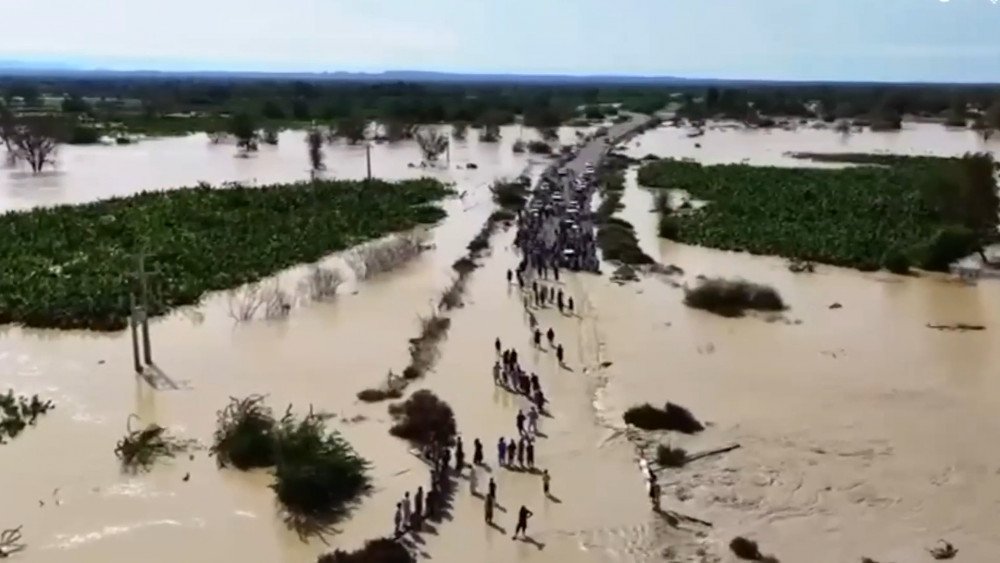
Massive flood, Sistan and Baluchestan Province, Iran
Road communication is disrupted, power supply is cut off, agricultural lands are destroyed, and there is no drinking water.
Residents of flooded areas were warned of a new danger: possible attacks by displaced Gando crocodiles.

Crocodiles, forced to leave their habitats due to flooding, Iran
Vietnam
From April 19 to 20, powerful storms with thunderstorms, hail, and heavy rains hit northern Vietnam.
In the country's capital, Hanoi, a prolonged thunderstorm occurred, with tornadoes and hail recorded in some places, causing significant property damage. Fallen trees damaged cars and motorcycles on the streets, and several people were injured. Storm winds toppled some power line supports.

Aftermath of a powerful storm in Hanoi, Vietnam
In the center and suburbs of Hanoi, up to 90 mm of rain fell. As a result, some streets were flooded, including the Vĩnh Tuy Bridge, which hampered road traffic and led to traffic jams.

Gusty wind on the streets of Hanoi, Vietnam
In Bắc Kạn province, 355 homes were left roofless. Moreover, strong winds destroyed over 70 hectares of corn crops.
In Cao Bằng province, hundreds of homes and schools were also left roofless due to the hurricane. Fallen trees and destroyed homes led to the death of hundreds of heads of livestock and poultry.
In Lai Châu province, due to heavy rains and gusty winds, a boat with two people capsized, and they are listed as missing.
In Yên Bái province, 147 homes and 2 factories collapsed, and 2 people were injured. More than 224 hectares of corn and forestry crops were destroyed.
At the same time, in Tuyên Quang province, heavy rain and storms caused serious damage to agriculture, damaging 54 hectares of rice and crops. During the storm, 117 homes were damaged.

Aftermath of the storm and heavy rains in Vietnam
In Hậu Giang province, a little girl tragically died, unable to escape from a house that collapsed due to heavy rain and wind.
As of April 22, according to the ASEAN Disaster Information Network (ADINet), more than 34,000 people in 11 provinces of Vietnam were affected. Approximately 7,000 buildings were damaged or completely destroyed, hundreds of hectares of crops were lost, and livestock and thousands of poultry heads.
Taiwan
On April 23, in Hualien County on the east coast of Taiwan, two powerful earthquakes with magnitudes of 6.0 and above occurred within just 6 minutes.
The first earthquake, measuring 6.0, was recorded at 2:26 AM. Its epicenter was off the coast of Hualien in the Pacific Ocean, with a focus at a depth of 10 km.

Aftermath of the Earthquakes in Hualien County, Taiwan
The earthquake was soon followed by a bigger magnitude 6.3 earthquake at 2:32 AM. Its epicenter was located in Hualien's Shoufeng Township with a hypocenter at a depth of 5.5 km. Over 100 aftershocks were recorded within 24 hours, 14 of them with magnitudes above 5.0. Reports indicate that two buildings in Hualien City, a hotel and a high-rise residential building, were partially damaged, while people were successfully evacuated. Additionally, some sections of local roads were closed due to rockslides and the risk of further rockfalls. Authorities decided to cancel classes in schools and office work for the day due to the risk of more aftershocks.
It is important to note that on April 3, Hualien County was affected by a 7.2 earthquake — the strongest in the region in the last 25 years. At least 17 people died. After this earthquake, about 1,100 aftershocks occurred:
Magnitude 6.0 and above: 4;
Magnitude 5.0 to 5.9: 56;
Magnitude 4.0 to 4.9: 344;
Magnitude 3.0 to 3.9: 706.
Africa
Torrential rains continue to hit East African countries, causing widespread flooding.
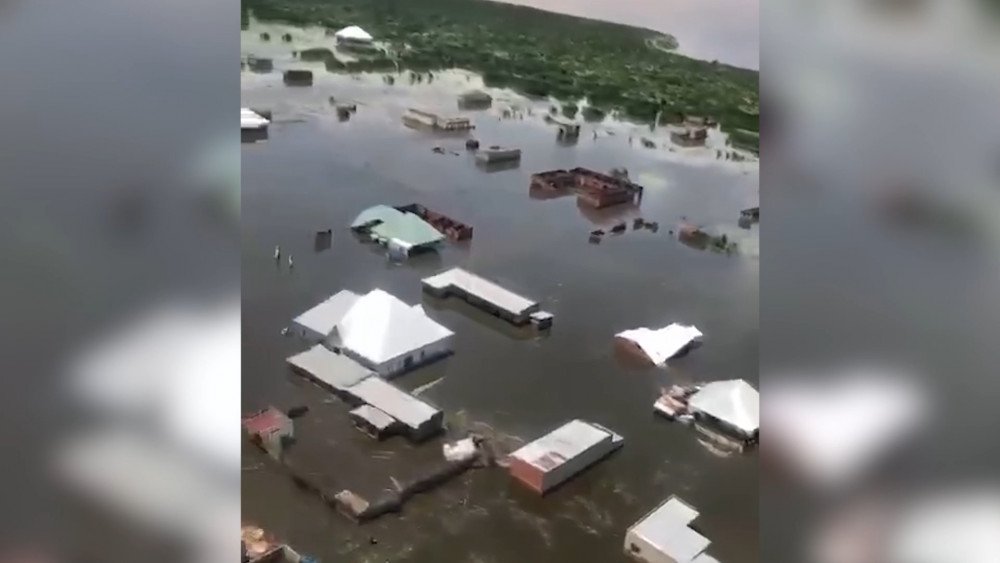
Massive floods in East African countries
Kenya
As of April 24, the ongoing floods in Kenya have claimed the lives of 38 people, with over 110,000 people forced to leave their homes. Some people are missing.

Destructive floods in Kenya
The rainy season that began in March brought sudden deadly and destructive floods to much of the country in April. Torrential rains caused rivers to overflow, damaged key infrastructure, led to the loss of livestock, and restricted access to major highways across the country.
In some parts of the central region of Kenya, rice fields were flooded with rainwater, while in other cases, corn crops were washed away by raging floods. In the northern, western, and eastern parts of the country, huge sections of major roads were destroyed, and some rural areas are now cut off from the rest of the world. Authorities are concerned that the prolonged large-scale loss of crops in regions considered breadbaskets, such as central and western Kenya and the Rift Valley regions, will lead to food security problems for a country already struggling to feed its citizens.
In the city of Nairobi, one of the most affected areas of the country, after 11 people died in one day, authorities are conducting rapid response operations. Residents of the “Safari Capital of the World” are in despair as their homes are flooded and roads have become impassable due to floods.
The Kenyan Red Cross warned that the situation is quickly spiraling out of control and turning from an emergency into a disaster that could have far-reaching consequences for people's health.
Tanzania
Since the beginning of the month, torrential rains in Tanzania have claimed the lives of 66 people. In total, floods have already affected more than 125,600 people.
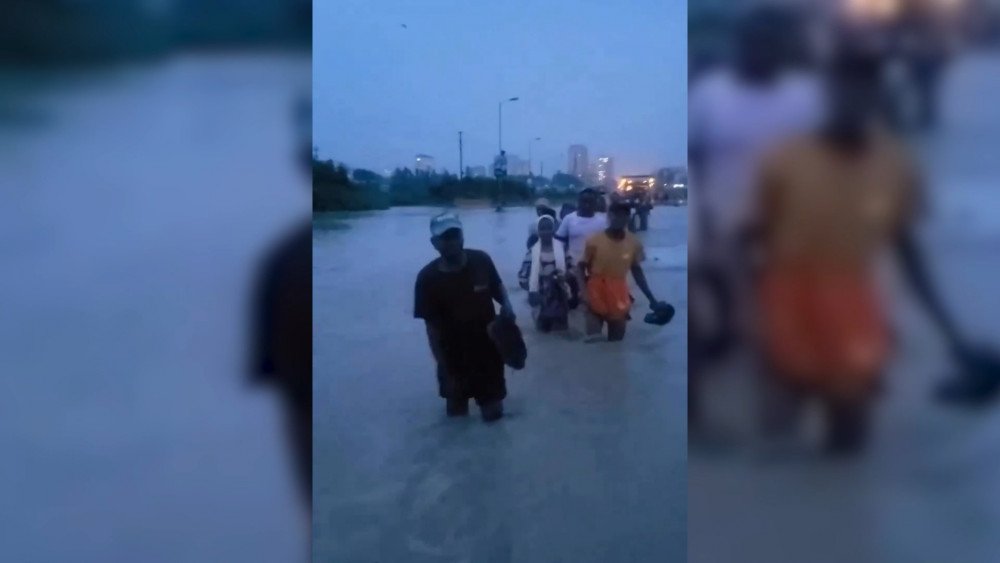
Deadly floods in Tanzania
The ongoing heavy rains have destroyed roads, caused landslides, and ruined numerous crops.
Burundi
On April 19, a giant landslide occurred in the Muhuta commune of Rumonge province in the southwest of Burundi, covering an area of 7 km². It destroyed a hydroelectric dam, damaged 497 homes, and several infrastructure facilities.

Giant landslide in Rumonge Province, Burundi
As a result, 2,485 people were displaced. More than 500 hectares of cultivated fields were destroyed. The village of Gabaniro suffered the most, with not a single home remaining. Several people were injured. Unfortunately, a child died.
North America
Canada
Regions in western Canada suffered from extreme drought. Subsequently, dried territories were engulfed by wildfires. Rescuers continue to fight several forest fire outbreaks.
As of April 22, more than 110 forest fires had been registered in the province of British Columbia, and 66 in neighboring Alberta.
36 wildfires from last year
did not extinguish and continued smoldering even under the snow,
and with the arrival of abnormal heat, they flared up again with renewed force.

Wildfires of the 2023 season smoldering under snow, Canada
The country faces the possibility of a repeat of the worst wildfire season in history in 2023, when 8 firefighters died and some 230,000 people were displaced from their homes.
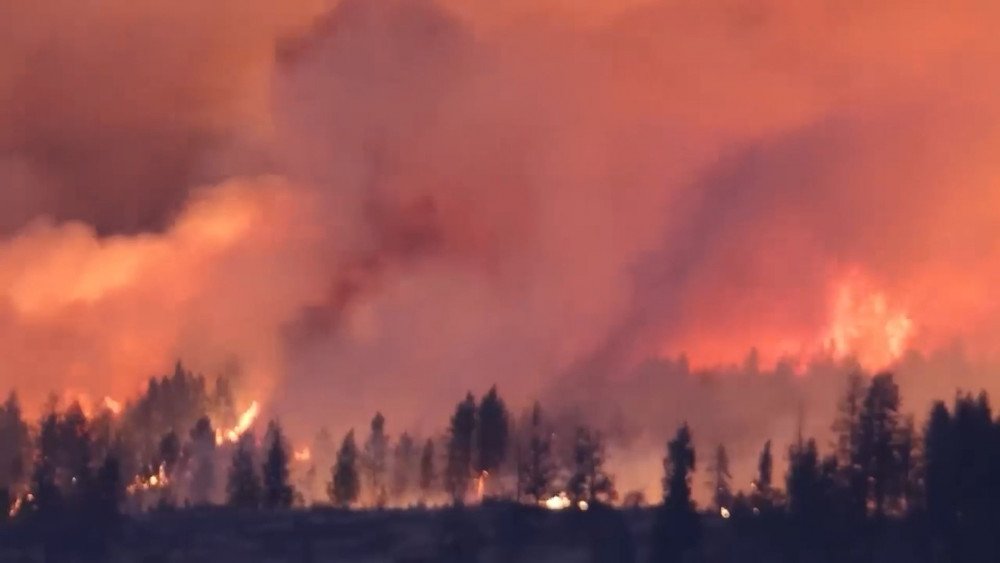
Worst wildfire season in the history of Canada, 2023
Europe
April brought unprecedented temperature chaos to Europe.
Europeans experienced one of the sharpest temperature fluctuations in recorded history. Summer heat at the beginning of the month was replaced by record-breaking temperature drops, snowfalls, and frosts by mid-month.
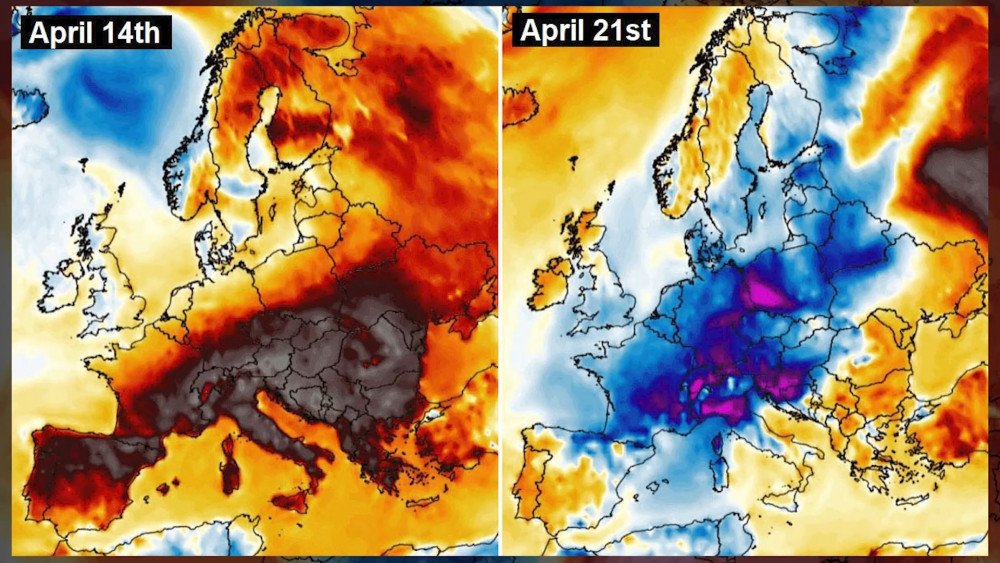
Abnormal temperature fluctuations in Europe
In some regions of Slovenia, the temperature dropped by 25 degrees or more, and already green fields were covered by a layer of snow.
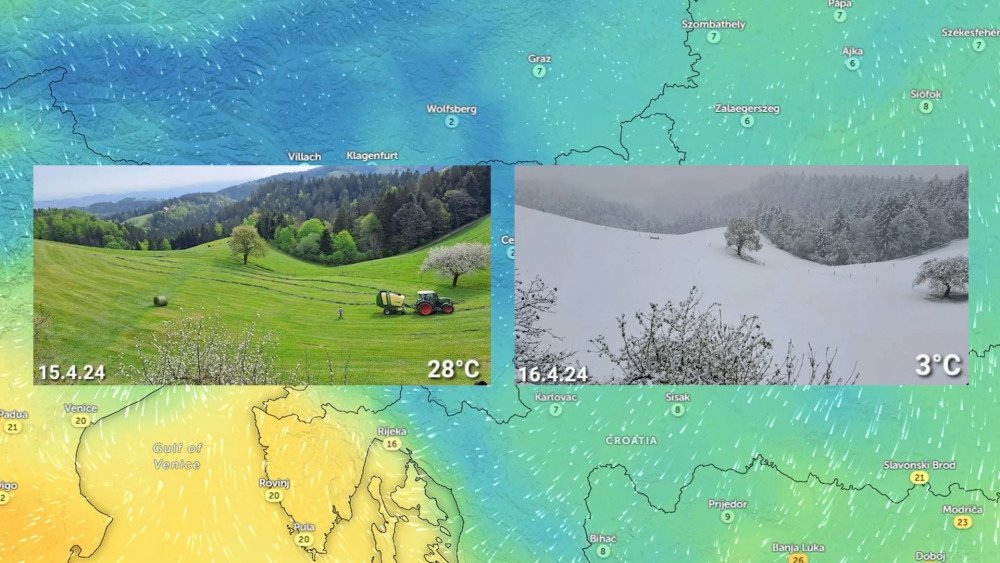
Record-breaking temperature drop in Slovenia
In the municipality of Podcetrtek, a record temperature drop of more than 26 degrees was registered. In just one day, the temperature dropped from 27.2 °C to 1.0 °C.
In Austria, in the city of Villach, the temperature dropped from 30 °C to 0 °C over two days.
In many regions of Europe, heavy snowfall occurred. In some places, more snow fell than during the entire winter. For example, in the German Alps, on the Zugspitze mountain, more than 40 cm of snow fell in one day, and over the next four days, snow cover grew to one meter. Road services were caught off guard and were unable to clear the roads of snow. This was a disaster for motorists who had already switched from winter to summer tires.
Unexpected heavy snowfall caused chaos on the roads of Bavaria: 25 cm of fresh snow, dozens of motorists stuck in their cars, fire brigades with chainsaws, and countless road closures.
In Helsinki, due to icy rain and snowfall, tram traffic was completely halted.

Transport collapse due to snow in Helsinki, Finland
Temperature swings seriously affected the region's agriculture. Fruit trees and vineyards, which bloomed several weeks earlier due to an abnormally warm spring, were affected the worst.
To save the harvest, German farmers lit 10,000 bonfires in the orchards during two days.
In France, frosts killed up to 70% of the grape and apricot crops.
In Poland, in the area of the city of Zawiercie, thermometers showed -7 °C in the morning of April 23. Rapeseed fields were frozen. Strawberry plantations were ruined, even though they were covered with agricultural fabric.
In Greece, fields with crops were buried under tons of water with snow, threatening a total loss of the harvest.
Russia
On April 19, in the European part of Russia, climate zones mixed. On the same latitude, the temperature difference reached 30 degrees Celsius. In the Volga region, it was warm like in the subtropics, while at the same time, arctic cold reigned in the west of Central Russia.
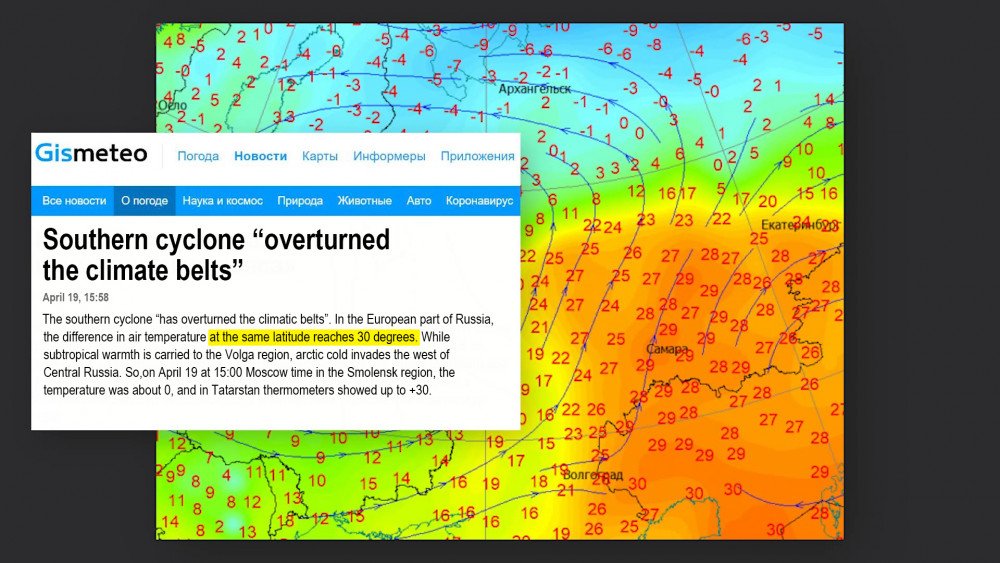
Abnormal temperature contrast within the same latitude, Russia
On the night of April 20, at least in 16 regions of Russia, rare — for the middle latitudes of the country — northern lights were observed.
Residents of Chelyabinsk, Ryazan, Penza, Vladimir, Sverdlovsk, Kurgan, Novosibirsk, Moscow, Nizhny Novgorod, and other regions witnessed an atypical phenomenon for their regions.

Atypical polar auroras in the mid-latitudes over the regions of Russia
The cause was a strong G3-class magnetic storm. It was not predicted by scientists because, according to their calculations, the coronal mass ejection from the Sun was supposed to pass tangentially and should not have caused significant disturbance to the magnetosphere. However, its reaction turned out to be much stronger, which indicates a critical weakening of our planet's magnetic field.
This means that we are becoming defenseless against cosmic radiation, there is an increased risk of burns from UV rays and skin cancer. The weakening of the magnetic field also negatively affects the mental health, blood composition, and overall well-being of people.
This is just one symptom indicating that our planet is dying. The observed weather chaos is happening because humanity has entered an era of climate catastrophes.
What scenario will unfold next is now up to each person. Either we leave everything as it is — and cease to exist along with our common home within the next 10 years. Or we unite our efforts — and help the planet overcome this difficult period, thus preserving life on Earth.
You can watch the video version of this article here:
Leave a comment